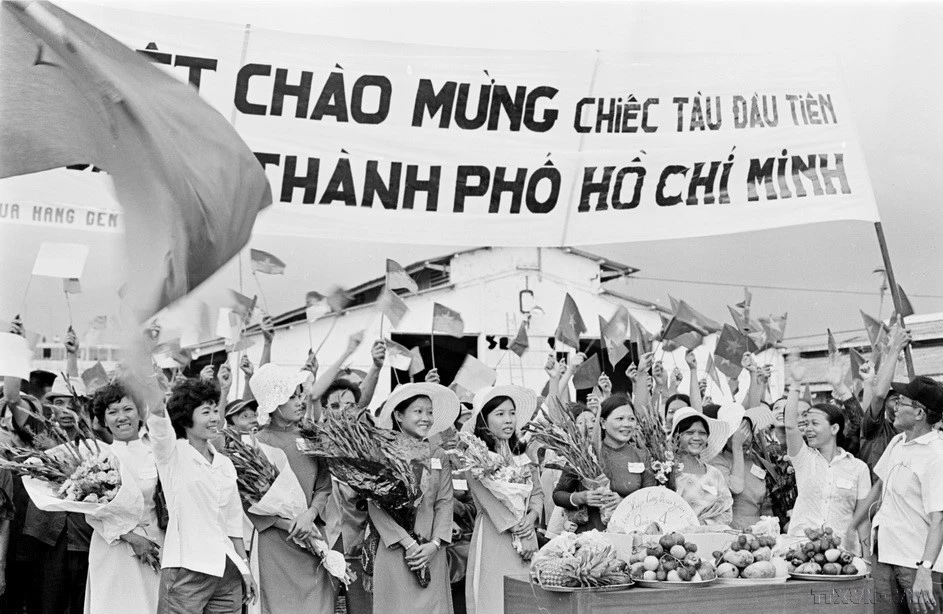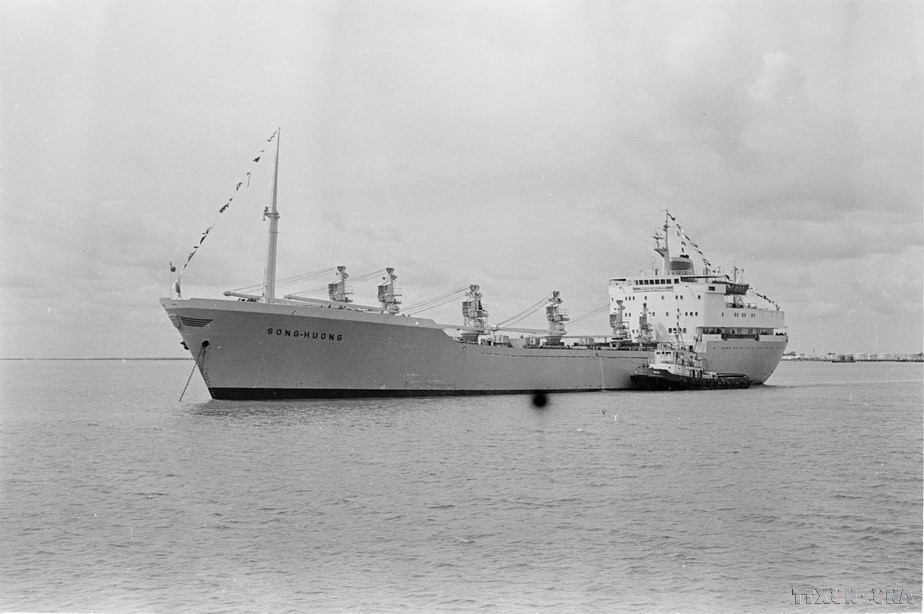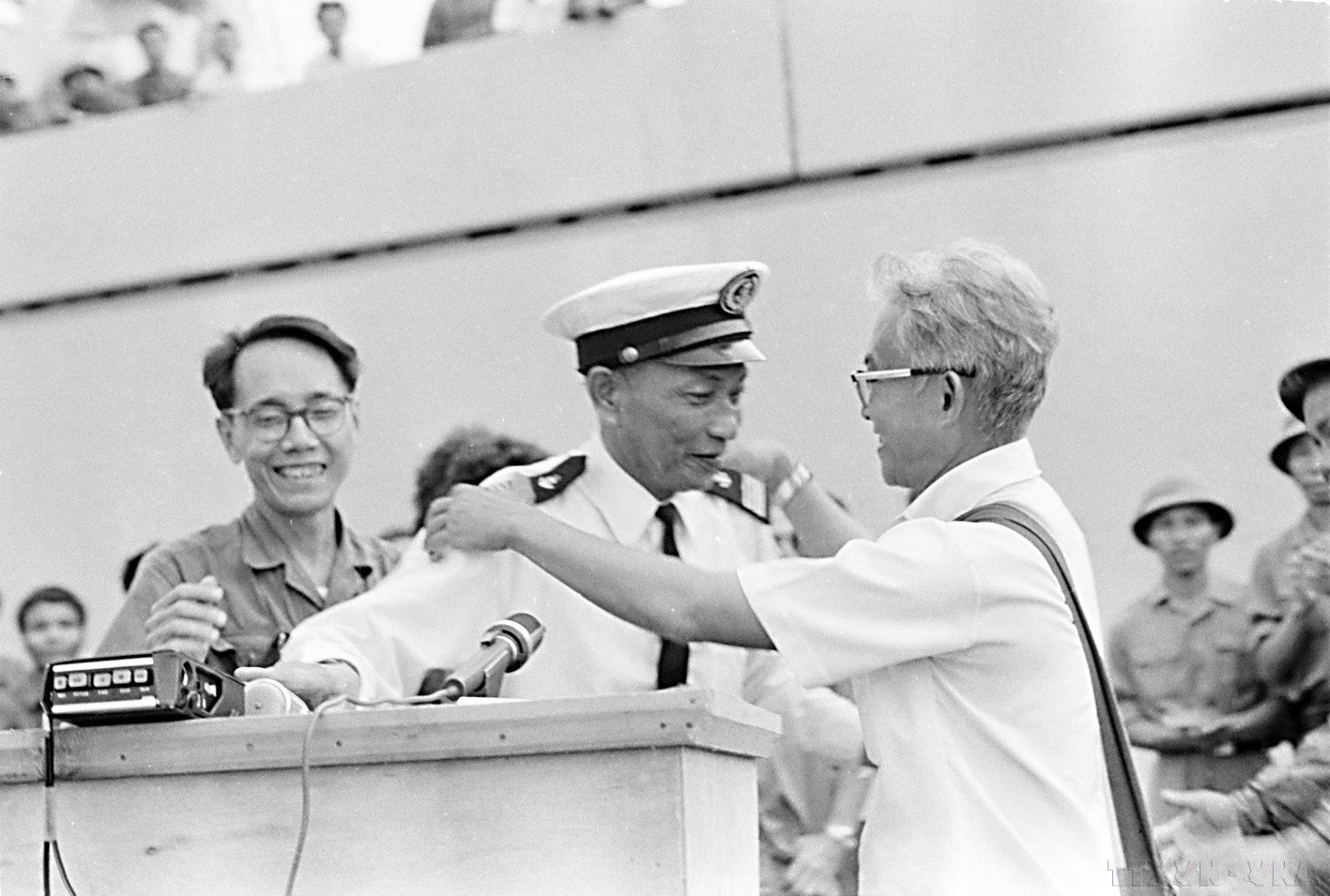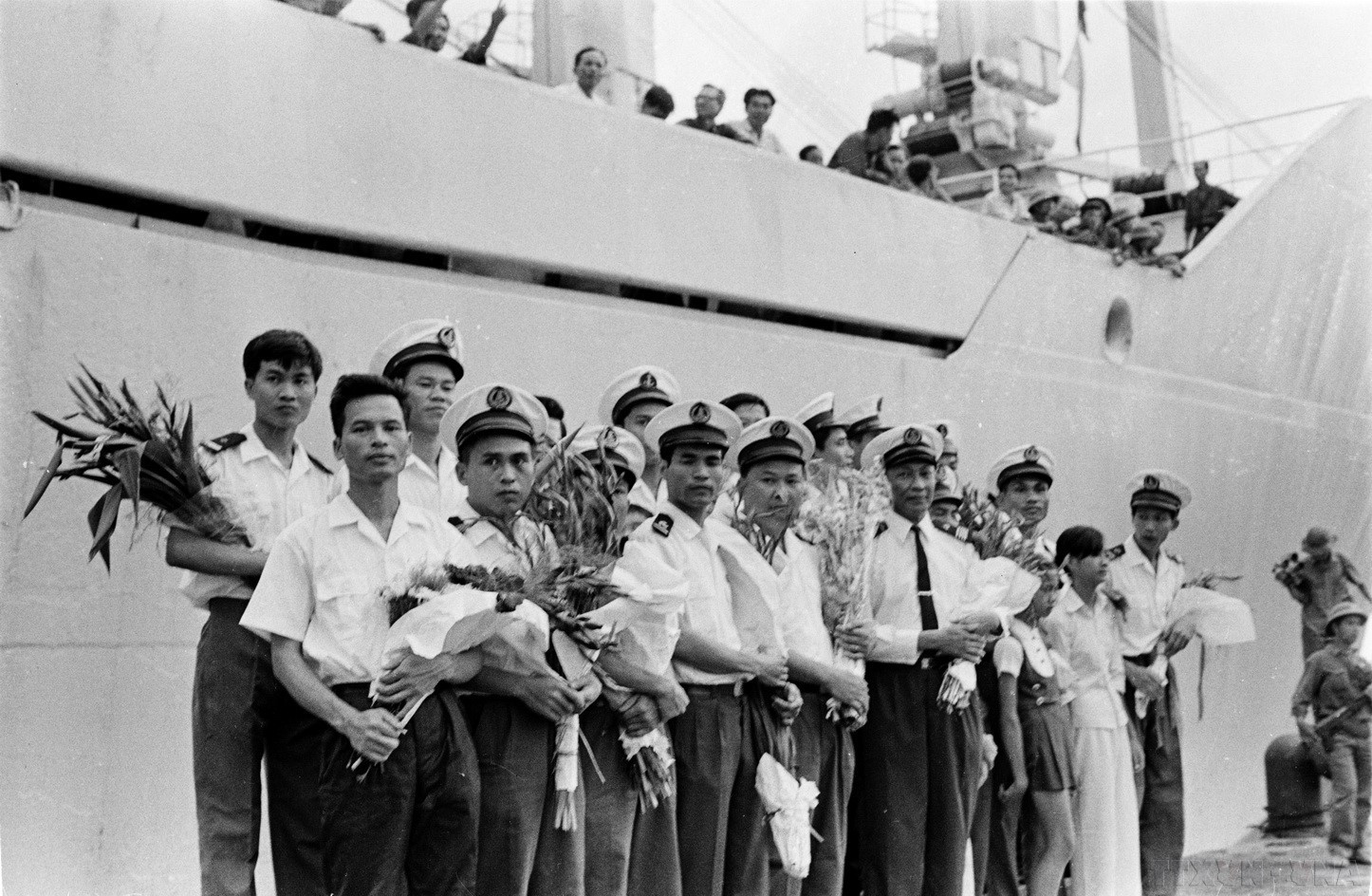
Representatives of unions and people at the rally to welcome the Huong River ship. (Photo: Quang Thanh/VNA)
During the process of construction and development, the Maritime industry has made worthy contributions to the cause of building and protecting the North, liberating the South, and unifying the country.
After the reunification of the country, the maritime industry has made a leap forward. From previously managing only 1,000km of coastline, it now manages 3,260km of coastline, the North-Central-South seaport system, domestic and international transportation routes, a seaport system ranked in the top 50 in the world and a logistics ecosystem extending to many regions of the country, creating the premise for a breakthrough in the era of national development...
Lesson 1: The first ocean liner with a symbolic journey of unity
During these heroic years, many ship crews and individuals contributed their strength, blood and even their lives to maintain the vital sea route, serving to support the Southern battlefield, ensuring the final victory and unification of the country.
"Wherever liberation goes, the sea route goes deep"
In the traditional room of Vietnam Ocean Shipping Company (VOSCO), there are still many documents about the formation and development process of the unit over the past 55 years, including the first ship connecting the two parts of the country after the liberation day.
With a slow and proud voice, Mr. Nguyen Quang Minh, General Director of VOSCO, told about the heroic history of previous generations of fathers and brothers, about the ocean-going ships carrying his children back to the South after 21 years since the country was reunited.
On July 1, 1970, VOSCO was established on the basis of unifying the transportation organization of the three fleets of Giai Phong, Tu Luc and Quyet Thang, initiating the shift from the method of operating maritime transport during the war to the method of organizing and managing transportation activities in conditions of half war, half peace.

The Liberation, Self-Reliant and Quyet Thang fleets transported many shipments to support the war in the South. (Photo: VNA)
During the period 1970-1975, VOSCO's name was associated with the period when the maritime industry devoted all its efforts to both production and combat missions. During this period, VOSCO ships were the shock force, participating in many large-scale transport campaigns from Hai Phong to Zone 4, from there transporting goods to the South to serve the resistance war against the US to save the country.
Under the rain of bombs and bullets, the VOSCO fleet steadfastly and bravely opened the Northeast transport route, received and transported goods, maintained the traffic arteries at sea, and fought side by side with other transport forces to contribute to bringing the resistance war against the US to complete victory and unifying the country.
“The love for the country has been transformed by VOSCO transport soldiers into spirit, will, and indomitable determination, which are the first bricks to build the tradition of solidarity, courage, intelligence, and creativity of generations of staff, officers, and crew members,” Mr. Minh shared.
VOSCO mobilized most of its forces and vehicles, small ships went first, large ships followed, competing to transport closely following the footsteps of the liberation army to bring troops, weapons, and food to the South.
With the determination to meet the highest transportation requirements for combat and production in the South, in 1975, VOSCO and the entire Maritime industry actively participated in serving the General Offensive and Uprising in the Spring of 1975, contributing to the victory of our people's resistance war against the US to save the country.
To serve this historic campaign, VOSCO mobilized most of its forces and means, small ships went first, large ships followed, competing to transport closely following the footsteps of the liberation army to bring troops, weapons, and food to the ports where the enemy was destroyed or retreated, along with other transport forces to promptly serve our army's rapid attack. The company used 36 VS ships (50 tons) to carry missiles and military goods for combat.
With the motto "Wherever liberated, the sea route goes deep", just two days after the enemy withdrew from Thua Thien-Hue, the Company's ships entered Thuan An port. Da Nang had just been liberated for three days, four Liberation ships docked at the Han River wharf, then were assigned the task of transporting the evacuated people back to Hue; followed by Ben Thuy and Song Da ships, one after another, bringing goods to Da Nang, warmly welcomed by the people and comrades. When the enemy had just withdrawn from Phan Thiet and Xuan Loc, the Liberation and VS ships were also present in Quy Nhon and Nha Trang.
On April 30, 1975, Saigon was completely liberated, the history of the country turned a new page after years of division. Immediately after that, an emotional and meaningful sea journey was made. The ship named Song Huong with the North-South journey became a symbol of unity, hope and happiness of reunion.
Special orders for the train
Pointing to a time-worn black and white photo of the crew of the Song Huong ship being given flowers and warmly welcomed after docking at Nha Rong Port in May 1975, Mr. Minh continued to tell us about the origin of the Song Huong ship - the first ship with a North-South journey that became a symbol of unity, hope and happy reunion.
At that time, after the Paris Agreement was signed (January 27, 1973), from the beginning of 1974, with the consent of the Ministry of Transport, the Maritime Administration under the direct direction of Director Le Van Ky invested in purchasing a series of ships such as 3 dry cargo ships Song Huong, Dong Nai, Hai Phong (both with a capacity of 9,580 DWT) from Sweden and 2 oil tankers Cuu Long 01, Cuu Long 02 from Norway (both with a capacity of 20,840 DWT) by borrowing and handing over to VOSCO for management.

The Huong River Ship - the first ship with a North-South route - has become a symbol of unity. (Photo: Quang Thanh/VNA)
“The Song Huong ship was the most beautiful, largest, and most modern ship in Vietnam at that time. The ship was built in 1965, and the Company took delivery and put the ship into operation on December 19, 1974. This was a wise decision by Director Le Van Ky - a visionary, opening a new era for the development of Vietnam's maritime industry,” Mr. Minh recalled.
The Huong River ship was the most beautiful, largest and most modern ship in Vietnam at that time.
In early May 1975, when the Song Huong ship was on its way from Japan to Hai Phong port to deliver goods, it received a secret order from the Director of the Vietnam Maritime Transport Company: "The Central Government, the Ministry of Transport, the Maritime Administration and the Company request that after delivering the goods, the captain urgently take the ship to Ha Long Bay, choose a suitable, safe and discreet anchorage location, near Hon Gai port, quickly complete preparations to receive a special mission, transporting more than 500 Southern cadres sent by the Central Government to supplement the force to take over the liberated areas...
Receiving the order, Captain Nguyen Tan Nghiem quickly returned the ship to Hai Phong port. After delivering the goods, the ship rushed straight to the Ha Long, Hon Gai anchorage.
As an ocean-going cargo ship, the Song Huong normally only carries goods, and the living quarters are only good enough to accommodate about 40 crew members, not passengers. When carrying more than 500 people, the ship had to redesign almost the entire interior to accommodate special guests.
Returning home after 21 years of national division
On the night of May 9, 1975, the Song Huong ship welcomed 541 Southern cadres from Hanoi to Ha Long and boarded the ship. On the morning of May 10, 1975, Mrs. Ngo Thi Hue (aka Bay Hue, wife of the late General Secretary Nguyen Van Linh), who was then the Head of the Southern Department, boarded the ship and directly assigned tasks to the ship's crew members: Captain Nguyen Tan Nghiem, Political Commissar Le Cong Minh, Chief Engineer Tran Ngoc Giang, First Deputy Captain Nguyen Manh Ha, and the total number of crew members increased to more than 60 people.
After the ceremony to see the delegation of cadres back to the beloved South, at exactly 2:00 p.m., the ship weighed anchor and left Ha Long Bay, heading straight to the South under the command of Captain Nguyen Tan Nghiem - a son of Saigon. In just over a day of travel, the Song Huong ship passed the Son Tra peninsula, the southern sea of the Fatherland gradually appeared before our eyes. On the afternoon of May 12, 1975, the Song Huong ship arrived at the Vung Tau anchorage.

Captain Nguyen Tan Nghiem - a son of Saigon - steers the Huong River ship. (Photo: VNA)
On the morning of May 13, 1975, the Huong River ship left Vung Tau and headed to Saigon and at 2:00 p.m. it docked at Nha Rong port, where in 1911 Uncle Ho boarded the ship to find a way to save the country, receiving a warm welcome from his relatives and the people of the city named after him.
“This was the first train connecting the two parts of the country, bringing 541 cadres who had gathered in the North - the children of the South - back to their homeland after 21 years of the country being divided. Many people cried because they were able to return home,” Mr. Minh shared the stories of previous generations.
This was the first train connecting the two parts of the country. Many people cried because they could return home.
Following the Song Huong ship, the Hong Ha and Dong Nai ships continued to transport goods to Saigon and the southern provinces, promptly creating a "bridge" connecting the North and South right after the day the South was completely liberated.
According to the General Director of VOSCO, during these heroic years, many ship crews and individuals contributed their strength, blood and even their lives to maintain the vital sea route, serving to support the Southern battlefield, ensuring the final victory and unification of the country.
“Generations of VOSCO cadres and employees have the right to be proud and we are truly proud that in every historical period, VOSCO has made worthy contributions to the country's revolutionary cause. That is a part of the heroic history, one of the most beautiful epics of the tradition of Vietnam's Transport. That tradition has been built and preserved by many generations of workers with aspirations, ambitions, willpower and the highest determination,” Mr. Minh happily said./.
Lesson 2: The Maritime Industry plays a pioneering role in innovation and opening up the economy.

Presenting flowers to the crew of the Song Huong ship for successfully completing the mission of connecting the two regions of the country. (Photo: VNA)
(Vietnam+)
Source: https://www.vietnamplus.vn/chuyen-tau-bien-dau-tien-voi-hanh-trinh-bieu-tuong-cua-su-thong-nhat-post1035181.vnp




![[Photo] General Secretary To Lam attends the 80th Anniversary of the People's Court's Traditional Day](https://vphoto.vietnam.vn/thumb/1200x675/vietnam/resource/IMAGE/2025/9/13/ff42d08a51cc4673bba7c56f6a576384)

![[Photo] Vinh Hao-Phan Thiet Expressway has a frog's jaw](https://vphoto.vietnam.vn/thumb/1200x675/vietnam/resource/IMAGE/2025/9/13/a89ffa426f7a46ffb810cb1d7bdfb1b8)
![[Photo] Hundreds of meters of Hoi An coastline seriously eroded](https://vphoto.vietnam.vn/thumb/1200x675/vietnam/resource/IMAGE/2025/9/13/57c85b745a004d169dfe1ee36b6777e5)
![[Photo] General Secretary To Lam attends the Digital Popular Education Symposium - Digital National Assembly](https://vphoto.vietnam.vn/thumb/1200x675/vietnam/resource/IMAGE/2025/9/13/43ebd93f0f5e4d98a2749dab86def7cd)





























































































Comment (0)